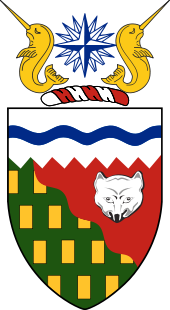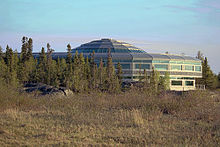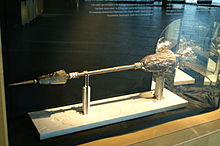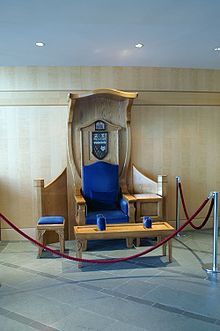- Legislative Assembly of the Northwest Territories
-
Legislative Assembly of the Northwest Territories 
Type Type Unicameral Houses Legislative Assembly Leadership Speaker Paul Delorey
since June 1, 2004Members 19 Meeting place 
Legislative Building, Yellowknife, Northwest Territories, Canada Website www.assembly.gov.nt.ca The Legislative Assembly of the Northwest Territories or Legislative Council of the Northwest Territories, Canada, is located in Yellowknife. The Assembly is a unicameral elected body that creates and amends law in the Northwest Territories. The Assembly was founded in 1870 and became active in 1872 with the first appointments from the Government of Canada.
Under the Northwest Territories Act the Assembly is officially defined under federal law as Legislative Council. However under Northwest Territories territorial law, it is defined as Legislative Assembly. Under different periods of its history it has alternated names.
Contents
Early history
The Legislative Assembly was first known as the Temporary North-West Council and was created in 1870. The first appointments to the council were made on December 28, 1872. The Temporary Council was dissolved in 1876 and a new permanent council was appointed and moved to the new capital of Fort Livingstone in 1876. The council moved to Battleford a year later based on the planned location of the Canadian Pacific Railway.
The very first election to the Assembly would take place on March 23, 1881 as Lawrence Clarke was elected to represent the electoral district of Lorne. In 1883 the Assembly moved south to Regina based on amendments to the route of the railway. The first territory-wide election took place on September 15, 1885 known as the 1885 Northwest Territories election.
Three years later the first general election took place. All the voting members of the Assembly were elected for the first time, and an elected speaker took office. The Lieutenant Governor still had executive authority however and appointed and ran the cabinet. After the second general election in 1891 the first fully elected Assembly without any appointed members. The Assembly achieved Responsible Government for the first time in October 1897 as the Lieutenant Governor appointed Frederick Haultain as the first Premier to form a government. Robert Brett became the first Leader of the official opposition and party lines were roughly drawn based on Conservatives and Liberals.
The Haultain government lobbied for Government of Canada for provincial powers for the Northwest Territories. In response on September 1, 1905 the provinces of Alberta and Saskatchewan were created by Prime Minister Wilfrid Laurier out of the southern populated portion of the territories.
Court of Law
The Legislative Assembly of the Northwest Territories served as the first court of law in the Northwest Territories from 1876 until the creation of the Supreme Court of the Northwest Territories in 1887. Appointed members of the council served as Stipendiary Magistrates would travel the territories and oversee legal cases when the Legislature was not sitting. In 1887 the Northwest Territories moved to a new system that assigned Judges to judicial districts and separated the legal and judicial branches.
Ottawa
After the creation of Alberta and Saskatchewan the rest of the Northwest Territories was sparsely populated by enfranchised voters. The territories reverted back to its confederation entry status. A new council was setup in Ottawa consisting of four appointed seats and under the authority of a Commissioner. The Commissioner was the effective replacement of the Lieutenant Governor.
Frederick White was appointed as the first Commissioner and did not recall the council to sit during his time in office. The first session of the 2nd Council of the Northwest Territories took place in 1921. The council members were bureaucrats appointed from the Interior Ministry and were not resident citizens of the territory. In 1947 The first Northwest Territories resident since 1905 was appointed to the council. John G. McNiven was appointed to represent Yellowknife. McNiven was also the first member appointed to the council from north of the 60th parallel.
In 1951 the council held its first general election in 49 years. The fifth general election elected three members from the District of Mackenzie. The old council was completely dissolved and five members were appointed along with the three elected representatives.
The council gained more powers back from the federal government as the population in the territory grew. In 1967 the Carrothers Commission moved the territorial capital from Ottawa to Yellowknife and for the first time elected members represented all parts of the territories. In 1975 the Legislative Assembly became fully elected, and the first elected speaker David Searle, since 1905 presided over the Assembly.
Consensus government
Commissioner John Parker gave up his powers of running the executive council and appointed George Braden as leader of the Government and the first Premier since 1905. The model of responsible government that was used this time around was known as Consensus government. The executive council or cabinet forms government while all the regular members form an unofficial opposition.
The modern Consensus Government model is inherently non-partisan and serves effectively as a constant minority government. The Legislature uses this model up to the current day.
Assembly buildings
The building that has housed the Northwest Territories Legislative Assembly has changed many times since it was founded. The first building was the original Manitoba Legislature in Fort Garry. After the council moved to Fort Livingstone it was housed in the Swan River Barracks used by the North-West Mounted Police.
The first building built for the needs of the Assembly was NWT Government House in Battleford. That building also served as a residence for the Lieutenant Governor. In 1883 the Assembly moved to Regina. The Territorial Administration building was built to accommodate the growing Assembly and used until 1905.
After the creation of Alberta and Saskatchewan, the capital was moved to Ottawa and the council sessions took place in an office building on Sparks Street. When the council sessions returned to the territories, they were held in any infrastructure suitable as they traveled from community to community.
After the capital was moved to Yellowknife in 1967 a temporary site for the Legislative Assembly was used until the new Legislature building was finished in 1993. The design of the current Legislature building was created by Pin/Taylor Architects company from Yellowknife.
Current Membership
The current Legislative Assembly is the 17th Northwest Territories Legislative Assembly. It is the 25th sitting of the territorial assembly since 1870.
The territories has fixed election date legislation that ensures elections are held every four years on the first Monday in October.[1]
The most recent general election, which was the 22nd general election was held on October 3, 2011. The legislature since 1905 is a non-partisan body and all members run and sit as independents.
Cabinet Ministers
The 11 ministers of the Government of the NWT is found in the Executive Council of the Northwest Territories.
See also
- List of Northwest Territories Legislative Assemblies
- List of Northwest Territories general elections
- Speaker of the Legislative Assembly of the Northwest Territories
References
- ^ Fixed election date in the N.W.T.: What does it mean, and why?
- ^ "Members Elect of the 17th Legislative Assembly of the Northwest Territories". Northwest Territories Legislature. October 4, 2011. http://www.assembly.gov.nt.ca/_live/documents/content/11-10-04%20Members-Elect%20Photo%20Sheet%20-%20Temp%20Photos%2017th%20Assembly.pdf. Retrieved October 14, 2011.
External links
Politics of Northwest Territories Commissioner 
Deputy Commissioner Premier Legislature Current assembly • Former legislatures • Current electoral divisions • Consensus government (1870-1898) (1905-present)Former Political parties (1898 - 1905) Elections Other Canadian politics  Canadian Legislative Bodies
Canadian Legislative BodiesParliament of Canada Legislative assemblies Alberta • British Columbia • Manitoba • New Brunswick • Newfoundland and Labrador • Northwest Territories • Nova Scotia • Nunavut • Ontario • Prince Edward Island • Quebec • Saskatchewan • Yukon
City councils Abbotsford • Barrie • Brampton • Brantford • Burlington • Burnaby • Calgary • Cambridge • Cape Breton • Charlottetown • Chatham-Kent • Coquitlam • Edmonton • Fredericton • Gatineau • Greater Sudbury • Guelph • Halifax • Hamilton • Iqaluit • Kingston • Kitchener • Laval • Lévis • London • Longueuil • Markham • Mississauga • Moncton • Montreal • Niagara Falls • North Bay • Oakville • Oshawa • Ottawa • Quebec City • Regina • Richmond • Richmond Hill • St. Catharines • Saint John • St. John's • Saanich • Saguenay • Saskatoon • Sault Ste. Marie • Sherbrooke • Surrey • Thunder Bay • Toronto • Vancouver • Vaughan • Victoria • Whitby • Whitehorse • Windsor • Winnipeg • Yellowknife
Categories:- Legislative Assembly of the Northwest Territories
- Northwest Territories courts
Wikimedia Foundation. 2010.




